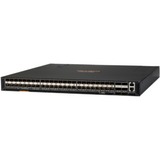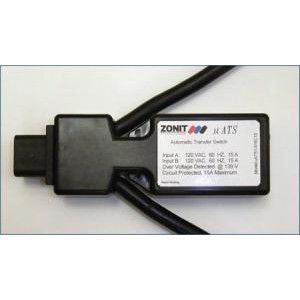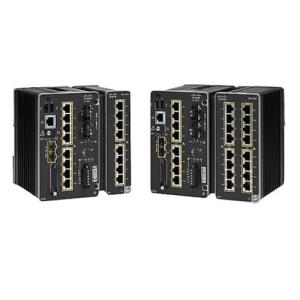HPE 8320 Ethernet Switch - 3 Layer Supported - Modular - 357 W Power Consumption - Optical Fiber - 1U High - Rack-mountable JL479A#B2B
JL479A#B2B | Aruba Networks®
New Listing!
Part Number: JL479A#B2B
Condition: New
In Stock:
Out of stock
Real time availability 
Notify Me
Product Specifications
HPE 8320 Ethernet Switch - 3 Layer Supported - Modular - 357 W Power Consumption - Optical Fiber - 1U High - Rack-mountable JL479A#B2B
ARUBA 8320 48 10/6 40 X472 5 2 PERP - BDL JMPCBL-NA/JP/TW PL-NV
Manufacturer Part Number: JL479A#B2B
MANUFACTURER NAME: Aruba Networks
MANUFACTURER PART NUMBER: JL479A#B2B
UPC EAN CODE: 190017195667
LANGUAGE: EN
MARKET:US
| General Information: | |
The past several decades in networking have been defined by static, closed networking solutions designed for the client-server era. The Aruba 8320 Switch Series, a campus core and aggregation switch, is a game-changing solution that offers an innovative approach to dealing with the demands of the mobile, cloud and IoT era. The Aruba 8320 is based on ArubaOS-CX, a modern software system that automates and simplifies critical and complex network tasks, delivers enhanced fault tolerance and facilitates zero-service disruption during planned or unplanned control-plane events. The key innovations in ArubaOS-CX are its micro-services style modular architecture, REST APIs, Python scripting capabilities and the Aruba Network Analytics Engine. The Aruba 8320 Switch Series provides line rate 10GbE/40GbE in a compact 1U form factor and together with the modular Aruba 8400 Switch, rounds out the Aruba Mobile First switching portfolio with an enterprise core and aggregation solution. What's new
Features Game-changing Business Agility The Aruba 8320 Switch Series is a campus core and aggregation switch solution with an innovative and powerful approach to dealing with the new applications, security and scalability demands of the mobile, cloud and IoT era. Fully programmable with ArubaOS-CX, it brings automation and visibility and helps troubleshoot via simple scripting. Aruba Network Analytics Engine provides the ability to monitor and troubleshoot the network, system, application and security related issues easily, through simple python agents and REST APIs. Offers high-speed fully distributed architecture with 2.5 Tbps switching capacity for always on networking. Provides robust security and QoS with advanced Layer 2 and Layer 3 features including support for BGP, OSPF, and VRF. Modern Software System Simplifies and Automates The Aruba 8320 Switch Series is based on the new ArubaOS-CX, a modern software system for the core that automates and simplifies many critical and complex network tasks. The built-in time series database enables customers and developers to develop software modules for historical troubleshooting, as well as analysis of historical trends, to predict and avoid future problems due to scale, security and performance bottlenecks. It includes stability, independent monitoring and restart of individual software modules, and enhanced software process serviceability functions. And it allows individual software modules to be upgraded for higher availability. High Performance The Aruba 8320 Switch Series includes a high-speed, fully distributed architecture and provides up to 2.5 Tbps switching capacity to meet the demands and bandwidth-intensive applications today and in the future. The compact 1U switch delivers line rate 10GbE/40GbE connectivity and very low latency for support of full Internet routes. You get resiliency and high availability with redundant power supplies and fans. | |
| Manufacturer | Hewlett Packard Enterprise |
| Manufacturer Part Number | JL479A#B2B |
| Manufacturer Website Address | http://www.hpe.com |
| Brand Name | HPE |
| Product Series | 8320 |
| Product Model | 8320 48p 10G SFP/SFP+ |
| Product Name | 8320 Ethernet Switch |
| Product Type | Ethernet Switch |
| Product UPC | 190017195667 |
| Interfaces/Ports: | |
| Modular | Yes |
| Port/Expansion Slot Details | 48 x 10 Gigabit Ethernet Expansion Slot
6 x 40 Gigabit Ethernet Expansion Slot |
| Media & Performance: | |
| Media Type Supported | Optical Fiber |
| Ethernet Technology | 10 Gigabit Ethernet
40 Gigabit Ethernet |
| Network Technology | 10GBase-X
40GBase-X |
| I/O Expansions: | |
| Total Number of Expansion Slots | 54.0 |
| Expansion Slot Type | SFP+
QSFP+ |
| Shared SFP Slot | No |
| Number of SFP+ Slots | 48 |
| Network & Communication: | |
| Layer Supported | 3 |
| Power Description: | |
| Power Source | Power Supply |
| Redundant Power Supply Supported | Yes |
| Power Consumption | 357 W |
| Physical Characteristics: | |
| Compatible Rack Unit | 1U |
| Form Factor | Rack-mountable |
| Height | 1.7" |
| Width | 17.4" |
| Depth | 19.9" |
| Weight (Approximate) | 20.72 lb |
Questions and Answers
Questions and Answers | Ask CompSource |
Shipping / Returns
Shipping
Ground =
FREE
(Delivery within 2-7 business days)
Two Day Air = $80.00
(Delivery within 2 business days)
Standard One Day = $133.00
(Delivery within next business day)
Priority = $154.00
(Delivery within next business morning)
U.S Mail Priority (AA,AE,AP only) = $78.00
FedEx International Economy (Canada only) = $140.00
Typically out of stock items are filled within 1 to 14 business days but can and may take longer.
Shipping dates are best estimates based on product location and may vary with holidays.
If product requires trucking, additional fees may apply.
* Some destinations are subject to Applicable State/Duty Taxes
Returns
CompSource realizes that every product may have different return guidelines. Please see the policy below regarding this item.
This Product Has Limited Exchange Privileges.
Please call for return guidelines.
For support on this product, please contact Aruba Networks.
Aruba Networks Company's Information
Product Reviews
Overall Rating | Write a Review
|
|
Best Sellers
More Best Sellers
Learn more about Switches & Bridges
Network Switch Buying Guide
Connect Multiple Devices to a Network and Route Data to Designated Devices
What is a network switch and what does it do?
A network switch connects devices to a local area network (LAN) and allows the devices to communicate over the network. For example, you can connect computers, printers and servers to the same network switch and route data between them. Unlike an Ethernet hub, which transmits the same data through every output, a network switch sends data only to the devices designated to receive it. This improves the efficiency and potential throughput of the network.

Are there different types of network switches?
There are two main types of network switches, unmanaged and managed. The essential difference is the capability to configure the operation of a managed switch to customize and optimize network traffic for specific applications.
Unmanaged Switches
- Offer plug-and-play functionality
- Switch operation cannot be modified
- CompSource offers desktop and rack-mount unmanaged switches
Managed Switches
- Provide the ability to manage, prioritize and monitor LAN traffic
- Offer one or more ways to modify switch operation
- CompSource offers smart managed switches that feature an RJ45 console port and command line interface (CLI)
Where do you place network switches?
Network switches are usually placed on a desk or table, mounted on a wall, or mounted in a rack. CompSource offers unmanaged desktop switches (with metal or plastic housing) and both unmanaged and managed rack-mount switches with metal housing and a built-in PDU (Gigabit Ethernet Switch PDU Combos).

What is a Gigabit Ethernet Switch PDU Combo?
CompSource offers an exclusive line of unmanaged and managed Gigabit Ethernet switches that have Power over Ethernet (PoE).

Factors to Consider
Does your application require a managed switch?
If your application involves controlling network traffic, you will need the features of a managed switch. The following are some examples of tasks that require a managed switch:
- Controlling access between departments within your LAN
- Running many bandwidth-intensive applications simultaneously
- Giving important data greater priority in your LAN
- Improving the performance of a busy network
- Implementing VoIP, wireless LANs or other advanced services
How many devices do you need to connect to your network?
Make sure you select a switch with enough Gigabit (10/100/1000 Mbps) Ethernet ports for the devices you want to connect to your network. If you think you'll add more devices in the future, choose a switch that will give your network room to grow.

Do you need to connect multiple network switches?
If you plan to connect multiple network switches, look for models with SFP uplink ports (also known as Mini-GBIC ports). SFP uplink ports are connection points for SFP (small form-factor pluggable) modules that allow the switch to uplink to other switches using optical fiber cabling.
Power over Ethernet (PoE) uses existing network cables to power connected devices, such as VoIP phones, wireless access points and surveillance cameras. If you need this functionality, look for a switch with Gigabit Ethernet ports that support PoE. Make sure the power per port (in watts) and the total power budget of the PoE ports meet the needs of your electronic devices.
CompSource will educate and help make this process enjoyable and easy.
Whether you're planning on using your network for basic home tasks or enterprise level security. You can tell our trained sales professionals your needs, and we'll make custom recommendations to suit your specifications and budget. Our reps have extensive knowledge and love to share. We educate, not sell, CompSource makes sure you buy what you need and not waste money on what you don't. As with every decision we never push, it's up to you when, and if you make a purchase.
CompSource has a great technical staff that can help with a solution for your exact needs.
Chat with us or give our professionals a quick phone call (800)-413-7361.
We do alot of online ordering and I must say you are by far the fastest and most informative of all. Thanks so much for excellent service to your customers. hotmatt_2000More Reviews























